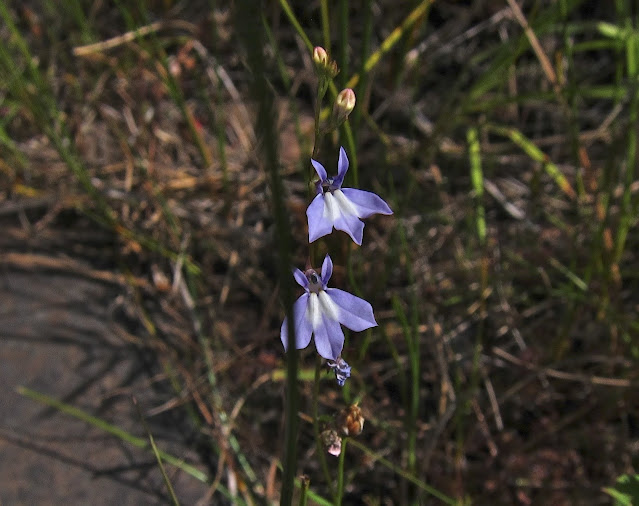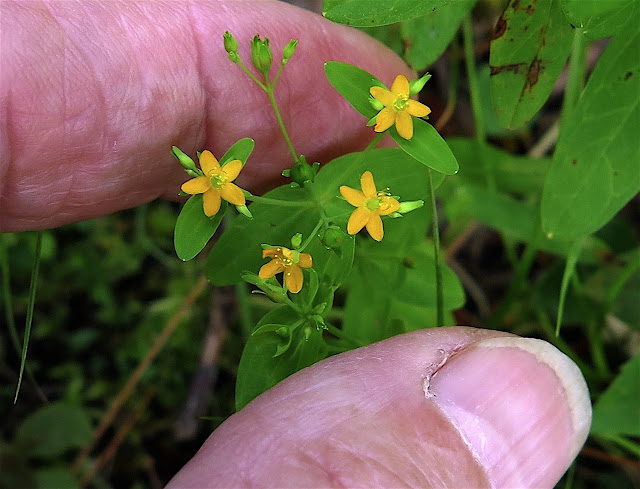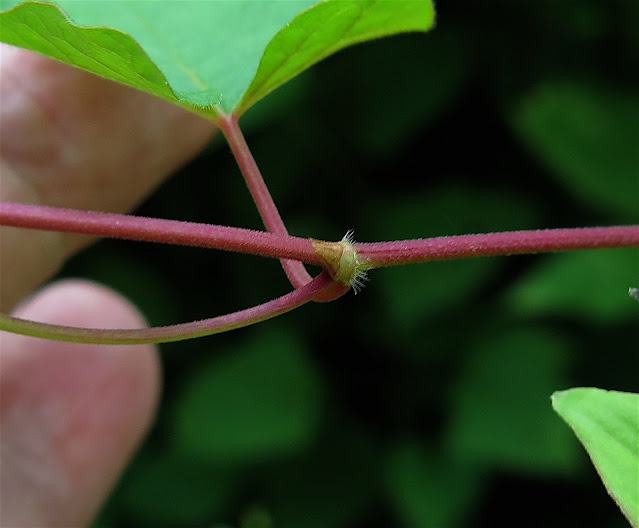Finally! After days of downpours with crashing thunder, alternating with days when the temps rose to 90 degrees in the sultry shade, a gentler sun rose kindly into a clear blue sky on July 10. This was one lucky day (and a cooler one, too) for the dozen "plant people" who ventured from far and near to explore one of the richest botanical sites in the region, the west bank of the Hudson River "Ice Meadows" in Warren County, New York. We were lucky, too, for more than the weather, because on this trip (sponsored by the New York Flora Association) we were fortunate to have with us one of our state's leading botanists, David Werier. That's David in the photo below, up to his knees in a plant-lined pool as he offers his careful instruction in how to tell one sedge from another. Again and again, David helped us discern many botanical treasures here that we might have overlooked without his discriminating eye and careful explanations. A fellow botanist, Robert Wesley (standing with notebook in hand), generously assumed the task of recording the huge number of plants we found. (UPDATE: A monumental task indeed! Robert has since submitted a list that includes 180 different species of plants, including woody ones and grass-like plants, as well as forbs. Thank you, Robert!)

Both climate and geology work together to create this remarkable habitat for rare plants along the Hudson's northern reaches. The wide, flat shore along this stretch consists of both granitic and calcareous rock, and springs deliver mineral-rich water from deep within the earth to pools that collect among the rocks. Even more significant are the monumental heaps of a special frothy ice (called frazil) that are deposited on these banks during the coldest parts of the winter, suppressing any woody growth that would eventually shade these shores, and chilling the earth beneath those heaps until they finally melt, sometimes not until quite late in spring, discouraging the encroachment of invasive plant species. Thus, the origin of the name, "Ice Meadows."

Here's a photo (taken a few years ago) of how monumental those ice heaps can be. They are not only deep, but also extensive, sometimes completely covering the riverside road and even pushing over trees in the roadside forest. This site is almost exactly where we parked our cars this week, having driven along the very road seen as impassable here. (It took many weeks for road crews to cut a passage through these ice heaps that winter.)
Some of the rarest plants that grow here had already finished blooming by the time of our visit, but we could certainly find them still, all by their foliage, and some, like this Dwarf Sand Cherry (
Prunus pumila var.
depressa), by ripening fruit. Although this sprawling cherry is rated as a Threatened (S2) species in New York, it grows abundantly here among the rocks on the sandy shore.
Observing how abundant Sticky False Asphodel (Trianta glutinosa) grows along these shores, it seems difficult to believe that this flower (now gone to ruby-red seed) could be rated as an Endangered species (S1) in our state.
New England Violet (Viola novae-angliae) is undoubtably the rarest plant we encountered here, for the east and west banks of the Hudson along this stretch of the river are the only locations where this distinctive native violet has been found in all of New York. The flowers had long gone to seed, but thankfully, this is a violet species that can be told by its long tapered leaves alone. And we found many of them.
I mentioned above how the weight of the winter ice suppresses the growth of woody plants. This applies to shrubs as well as trees, for out here we find shrubs that would tower over our heads in other locations, but here grow barely knee high. This Shadblow (Amelanchier sp.) was certainly mature enough to bear fruit, but it barely reached my mid-shins.
I'm sure the grass-lovers among us were delighted to have David's expertise to help them identify many different species of grasses and sedges that flourish out here, in what is essentially a riverside grassland. I still have much to learn in this area, but at least I know Turkey-foot Grass (Andropogon gerardii) when I see it, with its long seedheads spread apart like the toes of a turkey's foot.
One of the rarest sedges to thrive at this site is Brown Bog Sedge (Carex buxbaumii), which grows around some of the spring-fed pools among the rocks. It strikes me as odd that this sedge, rated as Threatened (S2) in New York and definitely a calciphile, would be dubbed with a vernacular name like "bog" sedge, since I think of bogs as acidic, not calcareous.
A number of native orchids have found a home on the Ice Meadows. The most commonly encountered is Rose Pogonia (
Pogonia ophioglossoides), which a couple of weeks ago was blooming here as thick as dandelions on a suburban lawn. Most had faded by now, but here and there we found one as lovely as ever.
Other orchids I have found here over the years include Tubercled Orchid, Smaller Purple Fringed Orchid, and Ragged Fringed Orchid. But not a one of those did we find today. We did find a Small Club-spur Orchid (Platanthera clavellata) though, although it was only beginning to open its florets. Perhaps some of those other orchids are yet to bloom as well.
Not all the plants we found today would be rated as rare. But some of us were surprised to see a goldenrod blooming so early in July. But that's how this particular species earned its vernacular name of Early Goldenrod (
Solidago juncea). This beautiful Red-blue Checkered Beetle (
Trichodes nuttalli) ornamented the already showy golden florets.
Kalm's Lobelia (Lobelia kalmii) is not a rare plant at all, but it does prefer wet calcareous rocks, which it finds in abundance out here on the Ice Meadows.
Harebell (
Campanula rotundifolia) also prefers rocky sites that are often watered, although it is not that picky about pH, so it can grow on either calcareous or acidic sites. Its delicate appearance belies its ability to withstand the harsh conditions it is often exposed to on riverbanks.
Marsh Bellflower (Campanula aparinoides) resembles a paler, much smaller version of Harebell, if you can find it hiding among the grasses, where it sprawls on weak slender stems.
Low-growing native roses abound on this shore, all with vivid-pink fragrant flowers. It takes some careful examination of leaves, thorns, and stipules to discern the species. My botanist friends did just that, and determined that this lovely thornless rose is called -- appropriately -- Smooth Rose (Rosa blanda).
If you wanted to find many of our native St. John's Wort species in one place, the Hudson Ice Meadows could surely satisfy your quest. The most noticeable one blooming now was Pale St. John's Wort (
Hypericum ellipticum), masses of which lined the pebbly shoreline, bearing lime-green leaves, bright-yellow flowers, and deep-orange flower buds. The scarlet seedpods are equally vivid, making me wonder how such a colorful plant came to be dubbed with such a misleading vernacular name as "pale".
You'd have to look a bit harder to notice the Dwarf St. John's Wort (H. mutilum), but only because it's so tiny, not because it is that less colorful.
Equally tiny are the flowers of Canada St. John's Wort (H. canadense), but this species can be distinguished from H. muticum by its very narrow leaves and abundant scarlet buds.
The Marsh St. John's Wort (
H. virginicum) is perhaps the most colorful one of all, with its purple-edged leaves, ruby-red buds and stems, and bright-pink flowers. If we'd chanced upon this plant later in the day, I bet the flowers would have been wide open, since this species doesn't usually open its flowers until about three in the afternoon. By that time, we were well upstream from this patch.
A number of aquatic species populate the spring-fed pools that accumulate in hollows of the bedrock. Although we arrived too late in the season to find any flowers of Flat-leaved Bladderwort (Utricularia intermedia), we could certainly see this species' distinctively whorled underwater leaves.
A second bladderwort, called Horned Bladderwort (U. cornuta), usually does not grow directly IN the water or float on the surface, but instead stands erect on long slender stems in the damp soils surrounding the pools. Its flowers are distinguished by the long, pointed spurs (its "horns") that protrude from the base of the flower.
Another denizen of the poolside rocks is Spatulate Sundew (Drosera intemedia), decorated today by its small white flowers. The sundew's deep-red, spiky pads are all sparkly with sticky droplets, meant to entice insect prey to land and be trapped by those very droplets until the pads close over the insect and feed on it. A plant without green leaves has to devise a way to obtain its needed nutrients in any way that it can!
By next month, these rocky pools will be ringed by numbers of the small flowers of Yellow-eyed Grass (Xyris sp.) held aloft on slender leafless stems. On this day, we found but a single one in bloom. But that was enough for David Werier to demonstrate the distinguishing features (hidden within the cone-like cluster of bracts at the base of the petals) that revealed this plant to be the Slender Yellow-eyed Grass (Xyris torta), rated as a Threatened (S2) species in the state.
Having found so many lime-loving plants here, it seemed a bit surprising to come upon a Northern Pitcher Plant (Sarracenia purpurea) with a lipstick-red bulbous big flower rising abruptly from a patch of sphagnum moss. This is a plant most often associated with acidic bogs. It is just this juxtaposition of acidic and basic habitats, often within just a few feet of each other, that makes this particular site such a fascinating site to explore for a wide variety of plants.
Large Cranberry (Vaccinium macrocarpon) is another plant usually found in wet bog conditions. And yet here on the Ice Meadows, masses of cranberry vines, studded with pinkish-white flowers, sprawled across rocks right next to where lime-loving plants like Sticky False Asphodel also thrived.

Although I (as a frequent explorer of this site) was ostensibly the leader of this botanical foray, I discovered that I had much yet to learn about some of the plants that grow here. At first glance, I thought I recognized this Frostweed flower as the species Crocanthemum canadense, even though that species had mostly stopped blooming for the year. Luckily, David was nearby to point out some features of this plant that proved it was instead Hoary Frostweed (C. bicknellii), a later-blooming species with a generally bushier appearance and with terminal flowers always surmounting the leaves. The flowers of C. canadense are almost always surmounted by leaves toward the end of their blooming time. I had never even realized that Hoary Frostweed grew in this part of the state! Or even that there WAS such a species of Frostweed. I learned something new, indeed!

Also, I had presumed that this mountain mint (Pycnanthemum sp.) was the common species called Narrow-leaved Mountain Mint (P. tenuifolium), since its leaves were rather narrow. Not narrow enough, though, David pointed out, as he also showed me how hairy were the stems of this plant compared to the stems of P. tenuifolium. This was instead the species called Virginia Mountain Mint (P. virginianum), another new species for my life list.
On all the previous occasions I have visited this part of the Ice Meadows with other botanical companions, we have ended our explorations when we reached the end of the shoreline bedrock pictured here. But many of our group were not nearly ready to stop, wondering what new treasures we might find along all that shoreline that beckoned from upstream. So on we traveled, pushing our way through trackless shrubs and grasses.

To tell the truth, I don't recall if we found any new botanical treasures further upstream, aside from those we had already seen. I do recall clusters of folks earnestly studying something or other here or there, but I was frankly growing weary, with an arthritic knee telling me it had had enough of scrambling over boulders and shoving through shrubs for the day. So when one of our group discovered we could climb a short bank to a railroad bed and thus have an easy walk back to our cars, I was truly delighted. And then, delighted yet again, when more botanical treasures were found right along this seemingly unpromising railroad right-of-way.
Here is David once more, showing a few rapt folks one of those treasures, a Mustard-family plant called Drummond's Rock Cress (Boechera stricta). What an unexpected find, for this state-listed Threatened species to be thriving among the surrounding "waste-place weeds" that typically grow in such seemingly unpromising soil!
Among the most distinguishing features of Drummond's Rock Cress are the long slender siliques (seed pods) that grow in a tight and nearly vertical cluster, which David here holds in his hand.
Yet one more surprise awaited along the same tracks. As I passed this flowering vine, I nodded in acknowledgment, thinking it was one I knew well, the familiar Black Bindweed (Fallopia convolvulus), a common non-native weed of vacant lots and city alleys. And once more, I would have continued in my misinformed state, if I had not been in the company of folks who know much more than I do about plants.

Those folks instructed me to take a closer look at the vines. "Notice the fine hairs surrounding the leaf nodes," I was told. "See how they all point downward?" Aha! Yes, I did see them! "They look like tiny tutus," I exclaimed. David teased me that "tutu" might be this Fallopia's specific name. I might have believed him, too, until I looked up Fallopia species in my Newcomb's Wildflower Guide and discovered its true identity, F. cilinodis (Fringed Bindweed). But the genuine specific name will be as easy for me to remember as tutu would have been. Each node is surrounded by cilia (hairlike structures); hence "cilinodis." Who says botanizing can't be fun?
I bet all of these smiling folks would agree that botanizing can be fun. They sure look like a happy bunch, don't they? I sure had a great time with them!
Front row, left to right: Tamara, Sue Pierce, David Werier, Amy David, Eric Wood.
Back row, left to right: Chris Graham, Jess Turner, William Hayden, Else Kolmos, Chuck Kieweg, Robert Wesley.
Missing: Jackie Donnelly (photographer).


































2 comments:
Those 'ice meadows' are some unique place for botanizing! And it's a rare day when YOU learn some new botany! I did recognize many of those from places up here like Dorcas Bay.
What a place! Sounds like you had a dandy time.
Post a Comment